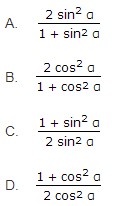41. The variation of steam pressure in the nozzle depends upon
A. velocity of steam
B. specific volume of steam
C. dryness fraction of steam
D. all of these
42. Steam turbines are used for
A. large marine propulsion
B. electric power generation
C. direct drive of fans, compressors, pumps
D. all of these
43. Parson’s turbine is a
A. simple impulse turbine
B. simple reaction turbine
C. impulse-reaction turbine
D. none of these
44. The value of the reheat factor varies from
A. 1.02 to 1.06
B. 1.08 to 1.l0
C. 1.2 to 1.6
D. 1.6 to 2
45. The steam enters the nozzle at a
A. high pressure and a low velocity
B. high pressure and a high velocity
C. low pressure and a low velocity
D. low pressure and a high velocity
46. The difference of supersaturated temperature and saturation temperature at that pressure is called
A. degree of supersaturation
B. degree of superheat
C. degree of undercooling
D. none of these
47. The maximum efficiency of a reaction turbine is

48. The ratio of the useful heat drop to the isentropic heat drop is called
A. condenser efficiency
B. nozzle efficiency
C. boiler efficiency
D. vacuum efficiency
49. The efficiency of steam turbines may be improved by
A. reheating of steam
B. regenerative feed heating
C. binary vapor plant
D. any one of these
50. In a reaction turbine, when steam flows through the fixed blades,
A. pressure increases while velocity decreases
B. pressure decreases while velocity increases
C. pressure and velocity both decreases
D. pressure and velocity both increases